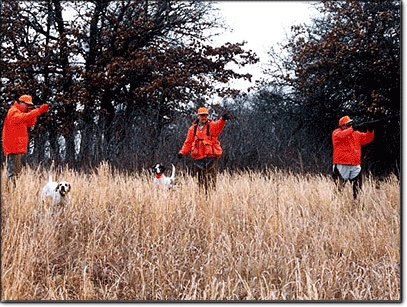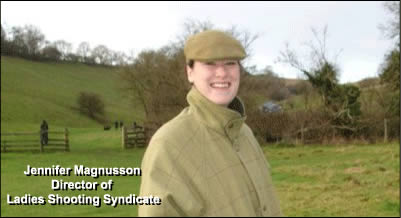Most shooters aren’t aware there is another shotshell manufacturer out there aside from the big four here in the United States. It’s RST and its has been around for a number of years. Their shotshells are manufactured in Friendsville, Pennsylvania, so they are not imported.
birds
Hunting Grouse With the Stealth Approach
The ruffed grouse is to the forest what pheasants are to the grasslands. But unlike the flashier, bigger plains bird, you can’t bully a grouse around. The “we-got-’em-surrounded” mentality that often works with pheasants – big crowds pushing a section of real estate to pinch birds and force them to flight – won’t get you anywhere in the grouse woods. No, this is one bird that requires finesse.
Traditional English Driven Shoots Come to the Big Hole Mountains of Idaho

Here at an altitude of 6,000 feet, the aromas of pine trees, sage brush and spent Holland & Holland shells mingle together in the Big Hole Mountains of Idaho where Lars Magnusson has introduced traditional English driven shoots on American soil.
Hunting the Wiley Chukar in Utah
Having hunted most of the species of upland birds in North America, I’ve come to appreciate the qualities of the chukar. Hunting chukar is an exciting adventure that always includes a surprise or two. Chukars are not only fun to hunt, they are also one of the most hearty birds to put down and typically don’t present a head shot on the rise as pheasant tend to do – making them challenging as well.
My Kansas Dream Hunt With Lee Horsley
 images/stories/travel/HagueHuntHorsley.gif[/caption]
images/stories/travel/HagueHuntHorsley.gif[/caption]A couple of years ago I received a call from a business acquaintance at Benelli USA, the good people who build a great shotgun. The call was an invitation to be a guest on an episode of Benelli’s Dream Hunts program airing weekly on The Outdoor Life Network now called Versus. Not being one to turn down any chance to hunt I quickly accepted without knowing any of the details at the time.
Thoughts On Waterfowl
One day last season, another hunter and myself put up a flock of seven-hundred black duck as we cut across the bay. That’s one continuous flock, all at once, of seven-hundred birds. Earlier, that morning, we put up another flock of two-hundred black duck. This has been the norm for many years where we gun on the Massachusetts coast.
According to the USFW, DU, and DW, the black duck is in decline. But from what I have seen in the past five years, you would never know it. The biologists tell us this is because the black ducks have shifted their range and we’re just seeing more ducks because they’re more concentrated. I remain skeptical. From my observations, I would say the black duck is thriving on the Massachusetts coast.
It bothers me to no end that our Canadian brothers can shoot four black ducks per day, but as soon as those same ducks enter the United States, we can only shoot one black duck per day. Why not get together with our Canadian brothers and level the playing field? Two black ducks per day, no matter where you gun. Of course, if you’re a Canadian, that would mean your daily bag limit of black duck would be reduced by fifty percent. Turn the tables and see how Americans would react if another country imposed such a restriction on us. What would Americans say then?
Eider duck numbers, everyone agrees, are way down. Maine to Massachusetts, we have all seen a huge reduction in birds in the past three years. Prior to 2003, we were seeing 2,000-5,000 flight birds per morning on the Massachusetts coast. Didn’t matter where you were gunning, the birds were thicker than flies. Three years later, we count ourselves lucky indeed, if we see 200-300 birds per morning!
The USFW and Tufts University are two organizations trying to figure it all out. I’m sure others are involved as well, but they need to toot their horn a little more and let us know what they are doing. I’d love to read full-length articles in magazines such as Ducks Unlimited, Delta Waterfowl, Outdoor Life, Massachusetts Wildlife, among many others, telling us about the problem and what biologists are finding out. On Cape Cod, thousands of eiders were found washed up on the shores in the summer and fall of 2007. Why? What can Sportsmen do to help?
Whatever happened to the media frenzy about Avian bird flu? “It’s definitely coming,” “get ready,” “huge death toll in American population possible,” were just a few of the threats. Warnings to waterfowlers were posted in all the hunting magazines. “Wear rubber gloves,” “wear surgical masks.” Cook your duck meat to a charred crisp!!! Forgive me, but I have to rank the Avian Bird Flu epidemic in America right up there with Global Warming and Darwinism. You don’t still believe in the big bang theory and that the human race came from monkeys, do you?
Capt. David Bitters is a writer/photographer and a striped bass/sea duck hunting guide from Massachusetts. His photos and essays have appeared in over one-hundred magazines. Capt. Bitters is currently finishing his first book, A Sportsman’s Fireside Reader – Tales of Hunting, Fishing, and Other Outdoor Pleasures. Contact him at captdaveb@baymenoutfitters.com or (781) 934-2838. You can also write him at P.O. Box 366 Duxbury, MA 02331
With Only the Clothes on Her Back: A Woman’s First Wingshooting Adventure in Argentina
Argentina. I could not believe it. My husband was taking me on my first wing shooting adventure. Granted, at this time I could not shoot my way out of a cardboard box, but it meant four days of “freedom” from the kids and four days of quality time with my husband. The adventure was about to begin.
Pheasant Phun
I was recently invited to go to South Dakota pheasant hunting, and what a trip it was. Kirstie Pike the President of Prois Hunting Apparel, Keli Van Cleave, and I went as Prois Hunting Apparel Pro Staff members and were treated to outstanding hospitality by the owners and staff of Pheasant Phun at the Olsen Ranch in Hitchcock, South Dakota.
Dave Olsen is the proprietor and the head wrangler of the operation. Dave’s mom, Annie, and his father, Art are some of the nicest people you will ever meet. The film crew of SSOutdoor Adventures was also there filming for an upcoming show.
Meet the New Ladies Shooting Syndicate

A venue for traditional wingshooting will soon open, tailored specifically for women – and it’s about time.
Called the Ladies Shooting Syndicate, it’s the brainchild of Blixt & Co. in Jackson Hole, Wyoming. The Ladies Shooting Syndicate is by membership only. It organizes splendid shooting trips to luxurious destinations for like-minded women. In effect, Blixt & Co. has transported the Golden Age of Shooting into the 20th century for women with adventurous sensibilities.
Birding with Balderrama or Hot-Barrel Hunting in Mexico
I had never thought of Mexico as a bird-hunting destination, but spending a week there has really changed my perspective. Some of the most exciting and fun hunting I’ve experienced recently can be had out of Los Moiches, Mexico where a variety of bird hunting is available along with excellent fishing and train touring as well.
Shotgun Life Newsletters
Join an elite group of readers who receive their FREE e-letter every week from Shotgun Life. These readers gain a competitive advantage from the valuable advice delivered directly to their inbox. You'll discover ways to improve your shooting, learn about the best new products and how to easily maintain your shotgun so it's always reliable. If you strive to be a better shooter, then our FREE e-letters are for you.
About Shotgun Life
Shotgun Life is the first online magazine devoted to the great people who participate in the shotgun sports.
Our goal is to provide you with the best coverage in wing and clays shooting. That includes places to shoot, ways to improve your shooting and the latest new products. Everything you need to know about the shotgun sports is a mouse-click away.
Contact
Irwin Greenstein
Publisher
Shotgun Life
PO Box 6423
Thomasville, GA 31758
Phone: 229-236-1632









